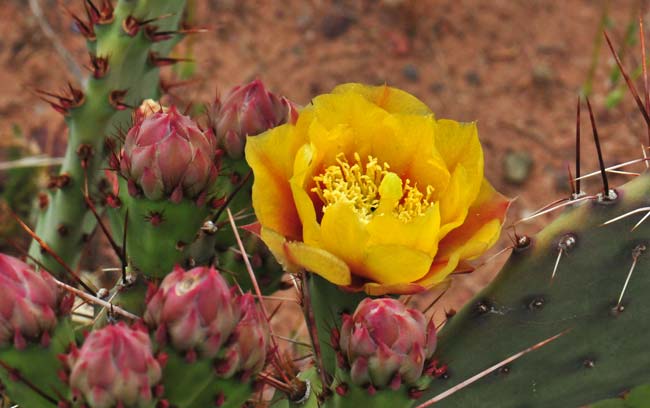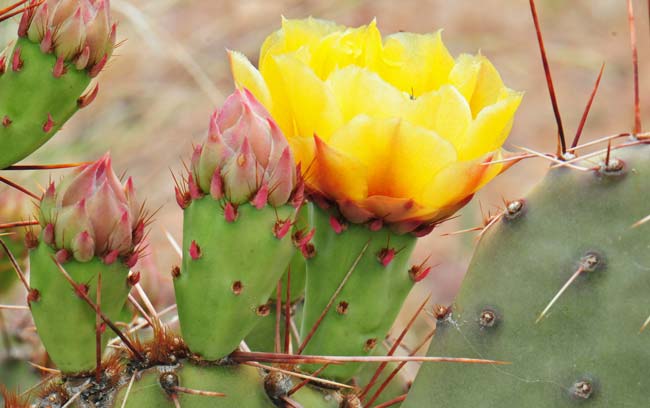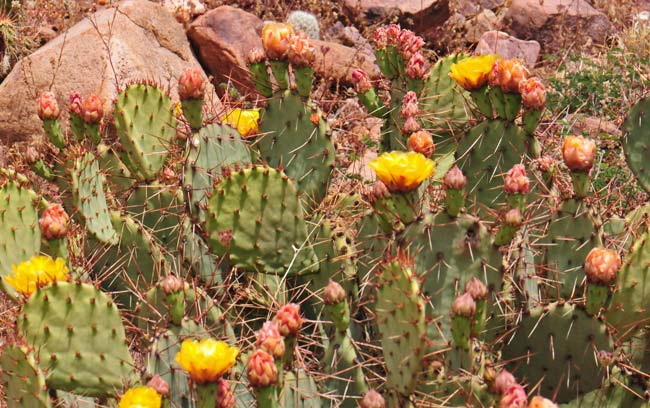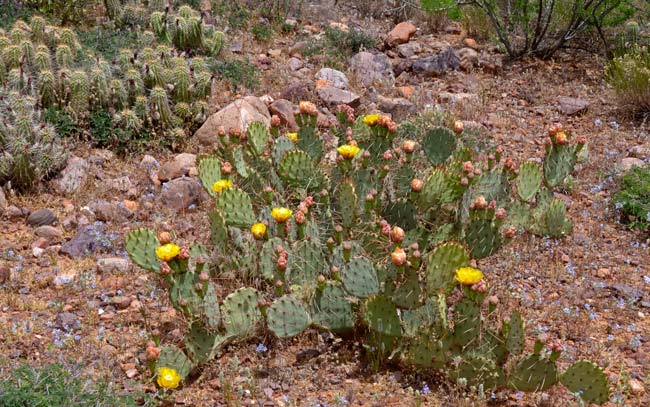Opuntia macrorhiza, Twistspine Pricklypear




Scientific Name: Opuntia macrorhiza
Common Name: Twistspine Pricklypear
Also Called: Bigroot Prickly Pear, Common Prickly Pear, Grassland Pricklypear, Plains Prickly Pear, Plains Twistspine Pricklypear, Prickly Pear, Twist-spine Prickly Pear, Western Pricklypear (Spanish: Nopal)
Family: Cactaceae, Cactus Family
Synonyms: ()
Status: Native
Duration: Perennial
Size: Up to 13 inches tall and 4 to 5 five wide.
Growth Form: Shrub; forming clumps, sometimes from tuber-like rootstocks, stems flattened obovate to circular, erect pad cactus; pads dark green; fleshy or flabby and cross wrinkled when stressed.
Leaves: Leaves modified into spines or glochids and emerging from areoles; spines from 0 to 4 per areole, erect to spreading, white to red-brown; glochids in dense tuft, pale yellow, tan to red-brown, aging brown.
Flower Color: Yellow with red, inner tepals yellow with red basal portions, filaments pale yellow, anthers yellow, style white, stigma lobes cream to yellowish; fruits green to yellowish to dull red, fleshy, glabrous.
Flowering Season: May to July.
Elevation: 2,900 to 6,100 feet.
Habitat Preferences: Sandy to loamy soils, gravelly soils, variable habitats; plains, chaparral, grassy woodlands and coniferous forests.
Recorded Range: In the United States Opuntia macrorhiza is common throughout all of the central portion in: AR, AZ, CO, IA, ID, IL, KS, LA, MN, MO, MT, NE, NM, OH, OK, SD, TX, UT, WI, WY. It is also native to central and northern Mexico. In Arizona it occurs throughout much of the state.
North America & US County Distribution Map for Opuntia macrorhiza.
U.S. Weed Information: No information available.
Invasive/Noxious Weed Information: No information available.
Wetland Indicator: No information available.
Threatened/Endangered Information: Arizona: Opuntia macrorhiza, Purple Prickly Pear is salvage restricted: Iowa: Bigroot Pricklypear is Endangered.
Genus Information: In North America there are 52 species for Opuntia. Worldwide, The Plant List includes 194 accepted species names and a further 203 scientific names of infraspecific rank for the genus.
In the Southwestern United States: Arizona has 16 species of Opuntia, California and Utah each have 10 species, Nevada has 6 species, New Mexico has 13 species, Texas has 23 species. All data is approximate and subject to taxonomic changes.
There are 2 varieties in Opuntia macrorhiza:
Opuntia macrorhiza var. macrorhiza, Twistspine Pricklypear (see range above);
Opuntia macrorhiza var. pottsii, Twistspine Pricklypear (AZ, NM, TX)
Comments: Twistspine Pricklypear is found throughout much of the mid-western United States reaching as far west as Arizona.
In Southwest Desert Flora also see: Beavertail Pricklypear, Opuntia basilaris; Cactus Apple, Opuntia engelmannii; Long-spined Prickly Pear, Opuntia macrocentra; Tulip Pricklypear, Opuntia phaeacantha and Santa Rita Pricklypear, Opuntia santa-rita.

